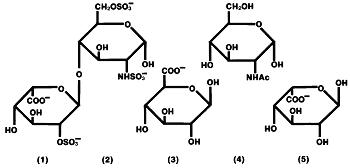Hep-Lock
Generic name: heparin sodium
Dosage form: injection
On This Page
Hep-Lock Description
Heparin is a heterogeneous group of straight-chain anionic mucopolysaccharides, called glycosaminoglycans, having anticoagulant properties. Although others may be present, the main sugars occurring in heparin are: (1) α-L-iduronic acid 2-sulfate, (2) 2-deoxy-2-sulfamino-α-D-glucose 6-sulfate, (3) β-D-glucuronic acid, (4) 2-acetamido-2-deoxy-α-D-glucose and (5) α-L-iduronic acid. These sugars are present in decreasing amounts, usually in the order (2)>(1)>(4)>(3)>(5), and are joined by glycosidic linkages, forming polymers of varying sizes. Heparin is strongly acidic because of its content of covalently linked sulfate and carboxylic acid groups. In heparin sodium, the acidic protons of the sulfate units are partially replaced by sodium ions.
Structural formula of Heparin Sodium (representative sub-units):

Hep-Lock U/P (Preservative-Free Heparin Lock Flush Solution, USP) is a sterile solution for intravenous flush only. It is not to be used for anticoagulant therapy. Hep-Lock U/P is specially formulated for use in situations where the use of preservatives is not advisable. Each mL contains heparin sodium 10 or 100 USP units, derived from porcine intestines and standardized for use as an anticoagulant, sodium chloride 8 mg, monobasic sodium phosphate monohydrate 2.3 mg, and dibasic sodium phosphate anhydrous 0.5 mg in Water for Injection. pH 5.0-7.5. The potency is determined by biological assay using a USP reference standard based on units of heparin activity per milligram.
Hep-Lock - Clinical Pharmacology
Heparin inhibits reactions that lead to the clotting of blood and the formation of fibrin clots both in vitro and in vivo. Heparin acts at multiple sites in the normal coagulation system. Small amounts of heparin in combination with antithrombin III (heparin cofactor) can inhibit thrombosis by inactivating activated Factor X and inhibiting the conversion of prothrombin to thrombin. Once active thrombosis has developed, larger amounts of heparin can inhibit further coagulation by inactivating thrombin and preventing the conversion of fibrinog...



